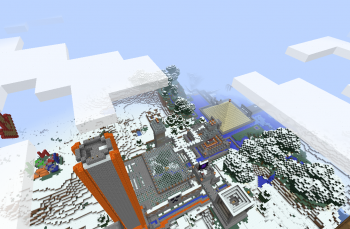Team Gameception’s Ludus Arena
Video Games and/as Theory, 2014
Alexander Callard, Chad Desgroselliers-Ashe, Alexandra Faraone, Madeleine Follis,
Sean Gallagher, Amanda Hughes, Alysha Hum, Savannah Smith
Team Gameception
Ludus Arena
14 years after its cinematic release, Ridley Scott’s Gladiator (2000) was still making a strong impression on students. The members of the Gameception group became interested in the notion that under the conditions of late capitalism, our sense of history is informed as much or more by media objects like films representing history as it is by textual accounts of history. Accordingly, they set out to build a gladiatorial arena in Minecraft.
The Ludus Arena was a huge oval-shaped structure loosely modelled on the Roman Coliseum. Beneath its floor was a functioning mob farm, complete with water-based elevator to bring monsters to the surface for prospective gladiators to fight. The arena was constructed very carefully, with layers of sand and obsidian to minimize damage from exploding Creepers. Audiences could observe the action from the stands, the Emeperor’s Box, or an overhead island. Like the Scavenger Hunt, the Ludus Arena became a popular minigame for other class members, and featured regular battles on most nights during term, with frequent cries of “Are you not entertained?” in the chat bar.
The chief theoretical takeaway for the members of the group was Fredric Jameson’s strong claim that postmodern culture’s sense of history has more to do with media pastiche than with historical fact. They realized, for example, that without giving the matter much thought, they had built a statue of a Greek god (Zeus) outside of a “Roman” building, which in turn led them to thinking about how Roman culture had also borrowed many of its own cultural elements from the Greeks.
A PDF of ther group’s original project proposal
A PDF slideshow of screenshots from the project

